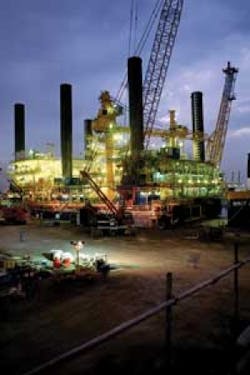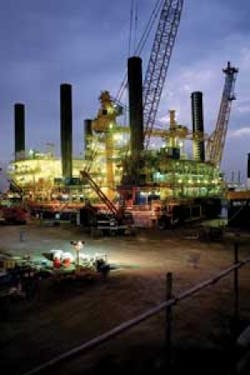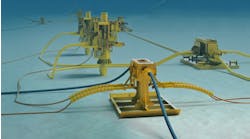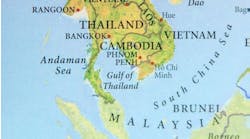Nick Terdre
Contributing Editor
A comprehensive program of platform removal and disposal is under way on the Ekofisk field complex in the Norwegian North Sea, where Heerema Marine Contractors’Thialf and Hermod crane barges have been in action this summer. Heerema’s firm scope of work for operator ConocoPhillips includes nine of the 15 platforms which form part of the Ekofisk I cessation program. These are Ekofisk 2/4 D, 2/4 P and 2/4 R, Norpipe 36/22 A and 37/4 A, Albuskjell 2/4 F and 1/6 A, Cod 7/11 A, and Edda 2/7 C. There are further options for Ekofisk 2/4 H and 2/4 Q.
Of the other platforms in the cessation program, Ekofisk 2/4 A, 2/4 B, and 2/4 FTP are still operational while 2/4 T, the Ekofisk Tank, has already been decommissioned.
Removal work started last year, with the topsides of 2/4 R, 36/22 A, and 37/4 A all taken out. The program for this year comprises the 2/4 F topsides and the 2/4 P, 2/4 R, 37/4 A, and 36/22 A jackets. By early August, all of these operations had been completed except for the 2/4 R jacket which was still in progress. At the same time, make-safe operations, a necessary preparation for removal, had also been completed on West Ekofisk 2/4 D and Edda 2/7 C.
Heerema’s crane-bargeThialf lifting out a redundant jacket at the Ekofisk center. Photo courtesy Kjetil Alsvik/ConocoPhillips.
Activities at the Ekofisk field center, where there is a concentration of bridge-linked platforms and subsea pipelines, are being performed byThialf using its dynamic positioning system, while Hermod, which lacks DP and employs anchors, takes care of the satellite installations.
Thialf was responsible for 2/4 P, a pump station, and 2/4 R, a riser platform, and Hermod for Albuskjell 2/4 F, a satellite platform tied back to the field center. However, both heavy-lift barges worked on the two booster platforms for Norpipe, the oil export line to the UK, with Hermod handling the topsides removal in 2009 and Thialf the single-lift jacket removal this year.
Albuskjell 2/4 F is one of the more demanding extractions. It was originally a PDQ platform, although the drilling derrick was removed in the late 1990s, leaving it with an 11,400-metric ton (12,566-ton) topsides supported by a 12-leg jacket weighing 6,900 metric tons (7,606 tons). Using a process of reverse installation, the topsides removal required 18 major lifts, one of them involving half of the module support frame, according to Mark M. Miller, ConocoPhillips Norge’s cessation manager. The jacket is due to be removed next year – Heerema’s contract sayseach jacket must be removed within one winter’s season of its topsides.
Last year, Heerema also completed a contract for the removal and disposal of light structures in and around Ekofisk. At the field center, this involved the bridges connecting 2/4 P and 2/4 R to the Ekofisk Tank, the bridge connecting 2/4 P to 2/4 C, and the topside modules on 2/4 P. In previous years, the contractor had removed flares, tripods, and bridge-links on the remote fields; as well as the northern flare, bridges, and tripod at Ekofisk center under this contract.
For both the light structures contract and the platform removal contract, the onshore disposal contractor is AF Decom, which has a decommissioning site at Raunes in western Norway, about 350 km (217 mi) from Ekofisk. The total weight of light structures which was landed and disposed of at Raunes was around 12,000 metric tons (13,228 tons). For the current program of topsides and jackets, it is expected to be close to 110,000 metric tons (121,254 tons).
Onshore disposal operations are going well, according to Miller. BothHermod and Thialf have made regular trips to the site, where their lifting capacity is needed to land the heavier items.
This year, ConocoPhillips received approval from Norway’s government for its plan to install a large new living quarter platform, 2/4 L, in 2013, at which point the H and Q installations will become redundant. However, no firm plans have yet been drawn up for their removal, Miller says.
Decommissioning activities at Ekofisk were unintentionally widened last year due to a collision between a vessel and the 2/4 W water injection platform. The damage was so severe that ConocoPhillips decided to decommission the installation. A plan is approved, and the platform will be removed next year.
The accident also put out of action the bridges on either side of 2/4 W and the south flare, which lay downstream of 2/4 W.Thialf removed these structures. Upstream of 2/4 W is 2/4 FTP, originally a processing platform, although its sole function now is as a riser platform for production from the 2/4 A wellhead platform. For the time being, both 2/4 A and 2/4 B, another wellhead platform, remain in operation.
The offshore phase of the platform removal contract is due to be completed by 2013 and onshore work by 2014.
Third-party platforms
There are three third party-owned redundant platforms which form part of the Ekofisk infrastructure. Two of them – 2/4 S, a riser platform alongside the Ekofisk Tank, and H7, a booster platform on the Norpipe gas export pipeline to Germany – are operated by Gassco. After negotiating with ConocoPhillips to have the removal of the 2/4 S jacket (the topsides were taken out in 2001) and the H7 platform included in Heerema’s program, Gassco decided to contract the work to Statoil.
The third platform is the BP-operated 2/4 G, another riser platform located beside the Ekofisk Tank. BP is undecided as to whether to have 2/4 G included in ConocoPhillips’ Heerema contract.
Offshore Articles Archives
View Oil and Gas Articles on PennEnergy.com




